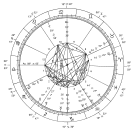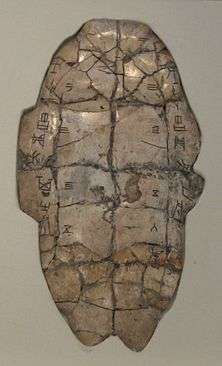Leo (astrology)
| Leo | |
|---|---|
 | |
|
| |
| Zodiac symbol | Lion |
| Duration (tropical, western) | July 22 – August 22 (2016, UT1)[1] |
| Constellation | constellation of Leo |
| Zodiac element | Fire |
| Zodiac quality | Fixed |
| Sign ruler | Sun |
| Detriment | Saturn (ancient), Uranus (modern) |
| Exaltation | Pluto |
| Fall | Mercury |
|
| |
| Astrology |
|---|
 New millennium astrological chart |
| Background |
| Traditions |
| Branches |
|
|
Leo (♌) (Greek: Λέων, Latin: Leōn), is the fifth astrological sign of the zodiac, originating from the constellation of Leo. It comes after Cancer (Greek: Καρκίνος, Latin:Karkinos) and before Virgo (Greek: Παρθένος, Latin: Parthenos). Under the tropical zodiac, the Sun transits this area on average between July 22 and August 23; the sign spans the 120th to 150th degree of celestial longitude.
Astrology

Astrology, in its broadest sense, is the search for human meaning in the sky; it seeks to understand general and specific human behavior through the influence of planets and other celestial objects. It has been argued that astrology began as a study as soon as human beings made conscious attempts to measure, record, and predict seasonal changes by reference to astronomical cycles.[2] Astrology is believed to have originated in China about the 3rd millennium BC. Its system is based on astronomy and calendars and its development is tied to that of astronomy, which came to flourish during the Han Dynasty (2nd century BC to 2nd century AD).[3]
Associations

Leo is a fixed sign along with Taurus, Scorpio, and Aquarius. Under the tropical zodiac, the Sun transits this area on average between July 23 and August 22 each year, and under the sidereal zodiac, the Sun currently transits this area from approximately August 16 to September 15.[4] The symbol of the lion is based on the Nemean lion, a lion with an impenetrable hide.[5] It is a northern sign and its opposite southern sign is Aquarius.[6][7]
Mythology
Greek mythology
Hellenistic astrology is a tradition of horoscopic astrology that was developed and practiced in the late Hellenistic period in and around the Mediterranean region, especially in Egypt. The texts and technical terminology of this tradition of astrology were largely written in Greek (or sometimes Latin). The tradition originated sometime around the late 2nd or early 1st century BCE,[8] and then was practiced until the 6th or 7th century CE. This type of astrology is commonly referred to as "Hellenistic astrology" because it was developed in the late Hellenistic period, although it continued to be practiced for several centuries after the end of what historians usually classify as the Hellenistic era. The conquest of Asia by Alexander the Great exposed the Greeks to the cultures and cosmological ideas of Syria, Babylon, Persia and central Asia. Greek overtook cuneiform script as the international language of intellectual communication and part of this process was the transmission of astrology from cuneiform to Greek.[9] Sometime around 280 BC, Berossus, a priest of Bel from Babylon, moved to the Greek island of Kos in order to teach astrology and Babylonian culture to the Greeks. With this, what historican Nicholas Campion calls, "the innovative energy" in astrology moved west to the Hellenistic world of Greece and Egypt.[10] According to Campion, the astrology that arrived from the Eastern World was marked by its complexity, with different forms of astrology emerging. By the 1st century BC two varieties of astrology were in existence, one that required the reading of horoscopes in order to establish precise details about the past, present and future; the other being theurgic (literally meaning 'god-work'), which emphasised the soul's ascent to the stars. While they were not mutually exclusive, the former sought information about the life, while the latter was concerned with personal transformation, where astrology served as a form of dialogue with the Divine.[11]
Chinese mythology

Astrology is believed to have originated in China about the 3rd millennium BC. Its system is based on astronomy and calendars and its development is tied to that of astronomy, which came to flourish during the Han Dynasty (2nd century BC to 2nd century AD).[3]
Chinese astrology has a close relation with Chinese philosophy (theory of the three harmony, heaven, earth and water) and uses the principles of yin and yang and concepts that are not found in Western astrology, such as the wu xing teachings, the 10 Celestial stems, the 12 Earthly Branches, the lunisolar calendar (moon calendar and sun calendar), and the time calculation after year, month, day and shichen (時辰).
Astrology was traditionally regarded highly in China, and Confucius is said to have treated astrology with respect saying: "Heaven sends down its good or evil symbols and wise men act accordingly".[12] The 60-year cycle combining the five elements with the twelve animal signs of the zodiac has been documented in China since at least the time of the Shang (Shing or Yin) dynasty (ca 1766 BC – ca 1050 BC). Oracles bones have been found dating from that period with the date according to the 60-year cycle inscribed on them, along with the name of the diviner and the topic being divined about. One of the most famous astrologers in China was Tsou Yen who lived in around 300 BC, and who wrote: "When some new dynasty is going to arise, heaven exhibits auspicious signs for the people".
References
- ↑ Astronomical Applications Department 2011.
- ↑ Campion 2008, pp. 1–3.
- 1 2 Pankenier 2015.
- ↑ Swift, Jackson (2015). "Astrology: Tropical Zodiac and Sidereal Zodiac". goarticles.com. Archived from the original on 18 November 2015. Retrieved March 24, 2016.
- ↑ Atsma, Aaron J. "Nemean Lion". The Theoi Project: Greek mythology. Retrieved July 27, 2016.
- ↑ "Leo". Encyclopædia Britannica. United States: Encyclopædia Britannica, Inc. Retrieved July 27, 2016.
- ↑ "Leo". Windows to the Universe. Arlington, Virginia: National Science Teachers Association. Retrieved July 27, 2016.
- ↑ Pingree, David Edwin (1997). "From astral omens to astrology : from Babylon to Bīnāker". Istituto italiano per l'Africa et l'Oriente : Distributed by Herder, International Book Centre. p. 26. Retrieved July 27, 2016.
- ↑ Campion 2008, p. 173.
- ↑ Campion 2008, p. 84.
- ↑ Campion 2008, pp. 173–174.
- ↑ Parker & Parker 1983.
Sources
- Astronomical Applications Department (2011). Multiyear Computer Interactive Almanac. 2.2.2. Washington DC: US Naval Observatory. Longitude of Sun, apparent geocentric ecliptic of date, interpolated to find time of crossing 0°, 30°....
- Campion, Nicholas (2008). A History of Western Astrology, Vol. 1, The Ancient World (first published as The Dawn of Astrology: A Cultural History of Western Astrology). London: Continuum International Publishing Group. pp. 1–3, 84, 173–174. ISBN 978-1441181299.
- Pankenier, David W. (2015). Astrology and Cosmology in Early China: Conforming Earth to Heaven (Paperback ed.). Cambridge: Cambridge University Press. ISBN 978-1107539013.
- Keen, Athena (2014). Cosmic Astrology: The Book of Answers. The Oracle's Library. p. 251. ISBN 978-0578151588.
- Parker, Derek; Parker, Julia (1983). A History of Astrology. New York City: HarperCollins. ISBN 978-0233975764.
External links
 The dictionary definition of Leo at Wiktionary
The dictionary definition of Leo at Wiktionary Media related to Leo at Wikimedia Commons
Media related to Leo at Wikimedia Commons- Warburg Institute Iconographic Database (over 300 medieval and early modern images of Leo)